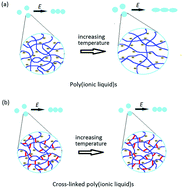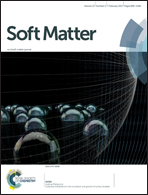Enhanced temperature effect of electrorheological fluid based on cross-linked poly(ionic liquid) particles: rheological and dielectric relaxation studies
Abstract
Recent research of using poly(ionic liquid) (PIL) particles as the dispersal phase has provided a new strategy to develop a high-performance anhydrous polyelectrolyte-based electrorheological (ER) fluid. However, the working temperature range of the ER fluid of PIL particles is still narrow due to an inherently low glass transfer temperature caused by the plasticization of polyatomic organic counter ions in PILs. In this paper, we develop a new ER system based on cross-linked PIL (C-PIL) particles and demonstrate that crosslinking with a suitable degree only slightly degrades the ER properties but significantly improves the working temperature range of the ER fluid of PIL particles. By using differential scanning calorimetry, rheology, and dielectric spectroscopy, we systematically study the ER properties of C-PILs and their temperature dependence at different crosslinking levels and understand the mechanism behind the improved temperature effect. The results indicate that crosslinking can effectively increase the glass transition temperature of PIL particles and enhance local ion-motion induced interfacial polarization by suppressing the thermally promoted long-range drift of mobile counter ions in the PIL matrix, and this results in the improved temperature effect of the ER fluid of C-PIL particles.



 Please wait while we load your content...
Please wait while we load your content...